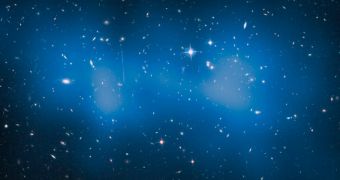According to new measurements conducted via the NASA/ESA Hubble Space Telescope, it would appear that the largest known galaxy cluster in the Universe is in fact 43 percent heavier than originally estimated. The object, known as ACT-CL J0102-4915 or El Gordo (the fat one, in Spanish), has been determined to weigh 3 million billion solar masses.
Astronomers operating Hubble were able to reach this conclusion after they measured the amount of gravitational distortion the cluster triggered in light released by objects around and behind it. Finding background galaxies for a cluster located around 9.7 billion light-years away was a challenge, but one that was easily surpassed with this telescope's huge observations power.
One of the most interesting aspects related to this cluster is that it existed at a time when the Universe was just a fraction of its current age. The Big Bang is estimated to have occurred roughly 13.75 billion years ago, which means that El Gordo already weighed 3 quadrillion solar masses 4 billion years later. Exactly how the cluster got to grow so fast remains a mystery to astronomers.
Hubble was able to conduct such precise measurements of its mass through a method called weak lensing, wherein the telescope's sensitive detectors analyzed how the extreme weight of the cluster created subtle distortions in the space around it. Light coming from even more distant galaxies behind El Gordo was also distorted, so scientists measured the intensity of this phenomenon.
Theory suggests that the more mass is stored in a cluster, the more it will distort light. Based on the amount of light distortion seen around El Gordo, scientists at the University of California in Davis (UCD) determined that the cluster must weigh 3 quadrillion solar masses. The structure contains several hundred galaxies, plus a massive number of gas clouds throughout its interior.
“What I did is basically look at the shapes of the background galaxies that are farther away than the cluster itself. It's given us an even stronger probability that this is really an amazing system very early in the Universe,” says UCD expert and lead study author, James Jee. He explains that a large part of the mass in El Gordo must be accounted for by dark matter.
“We were in dire need for an independent and more robust mass estimate given how extreme this cluster is and how rare its existence is in the current cosmological model,” explains University of Illinois in Urbana-Champaign (UIUC) expert Felipe Menanteau, a member of the research team.
“There was all this kinematic energy that was unaccounted for and could potentially suggest that we were actually underestimating the mass,” he goes on to say. Previous estimates of El Gordo's weight were based on measurements conducted in January 2012 with the NASA Chandra X-ray Observatory.
The European Southern Observatory's (ESO) Very Large Telescope (VLT) at the Paranal Observatory, in Chile, also contributed galaxy velocity measurements to the 2012 estimates. However, the issue was that the cluster might have been in the process of forming via a merger between two smaller clusters. This is where the sensitivity of Hubble came in, and solved the problem.

 14 DAY TRIAL //
14 DAY TRIAL //